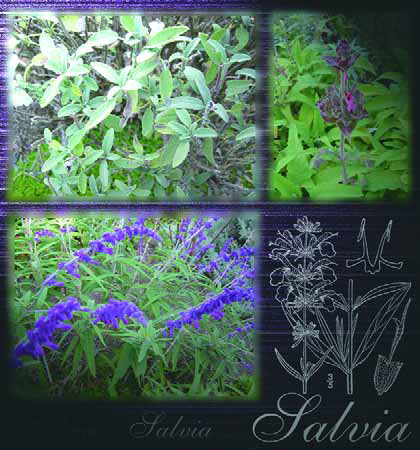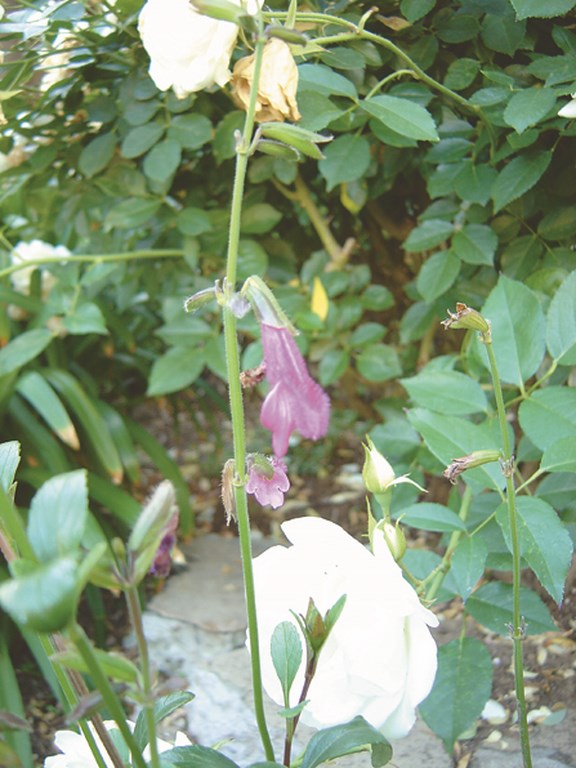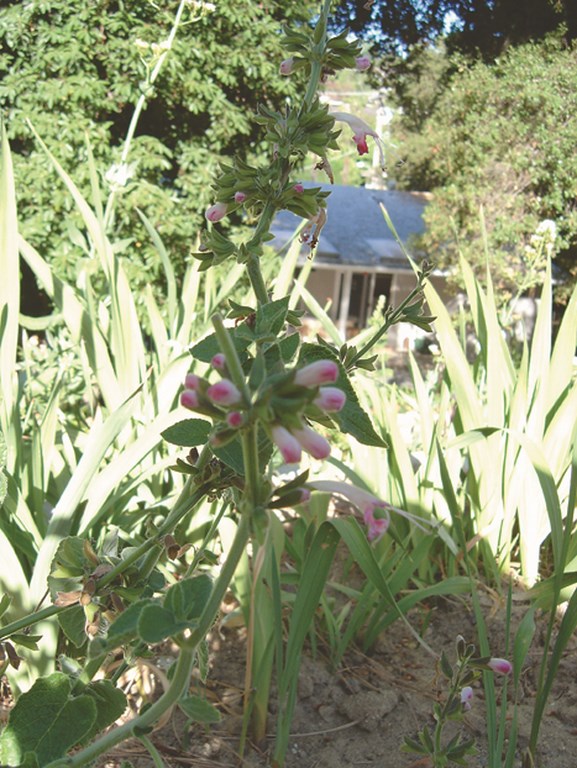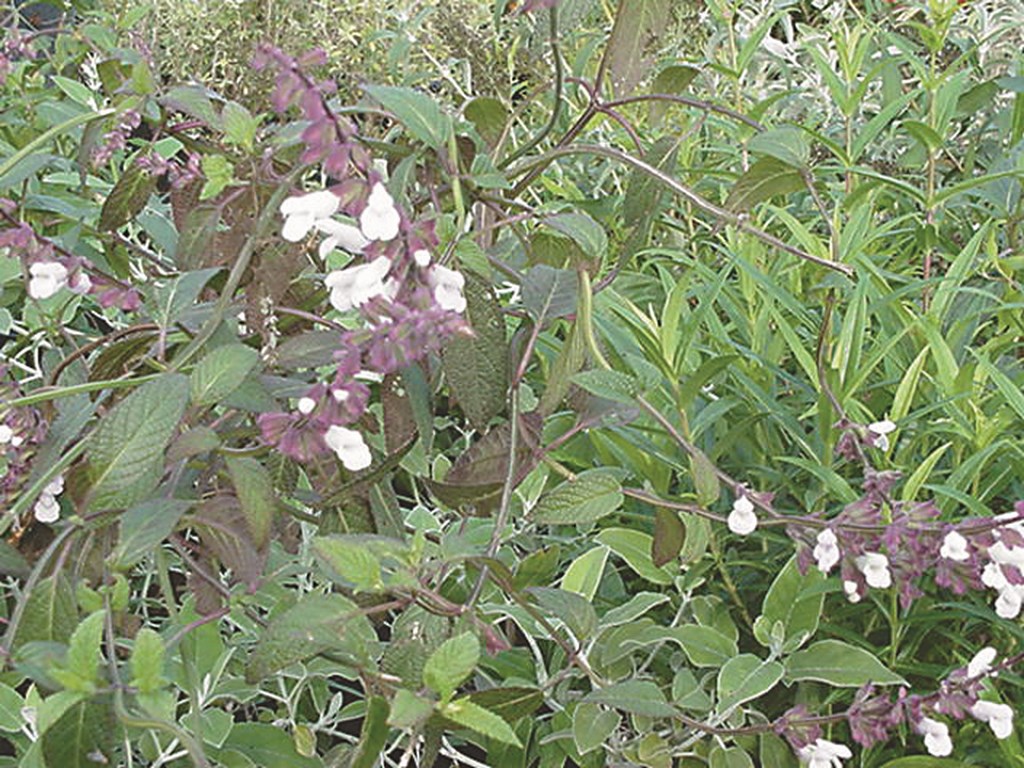Sage Advice

In preparation for creating plant palettes for my projects, I typically spend hours poring over my Sunset Western Garden book. I thrive on finding plants I haven’t tried before, and I look especially for those I haven’t seen in anyone’s garden.
Before I’ll try any of these discoveries out on someone else, however, I’ll pick up a sample plant and bring it home to my own garden – part science project, part proving ground to see how the plants perform away from the nursery.
I’ve had many successes through the years and probably as many failures, but I learn something from every attempt. What I sometimes find are plants that are extremely versatile, quite hardy and very beautiful that I never even knew existed or that had simply passed on as being too common – or, in the case of Salvias, that were already growing right under my nose, as we’ll see below.
MORE THAN HERBS
Salvia is the largest genus within the mint family. Widely known as sage, I prefer to think of the types I use in my projects as ornamental sages to distinguish the common garden plants from the herb variety of sage that is often used for cooking (and a lot more).
The typical growth habit of Salvia is upright, with smallish flowers ranging from white to deep purple and all colors in between. Some are woody, some are perennial and some are sold as annuals. They prefer full sun and ample water; when mature, however, many varieties can be quite drought-tolerant.
When choosing among Salvias, check to see if the specific type that’s caught your eye is evergreen or deciduous. Generally speaking, it’s best to go with evergreen varieties unless you’re placing them in the back of borders where they will be camouflaged during the winter. Climate zone is a major consideration here: Salvias that might be evergreen perennials in my area might be deciduous annuals elsewhere, which makes checking with your nursery or local garden guide an important step.
These plants are great in a garden for clients who have requested plants that attract hummingbirds, bees and butterflies. Some varieties are actually notorious bee attracters, including Salvia leucantha (Mexican Bush Sage). Without any other guidance, the best way to determine if a particular variety will pose a bee problem is to observe it on a warm spring or summer day in the nursery before you buy it.
I’ve also found that when I take clients to the nursery to introduce them to a range of Salvias, they typically point out different varieties they like among all the available plants without even knowing they’re looking at Salvias. I believe the primary attraction is the upright growth habit and the splashes of color, but whatever the source, I find that my clients who request native plants are, just like the birds and bees, drawn magnetically to Salvias.
CREATING STYLE
The great thing about Salvias is that they can be used in almost any design style. The plants’ forms lend themselves to contemporary-style gardens just as well as they do to wild and natural settings. Better still, these plants tend to generate little to no litter, making them ideal for placement near watershapes.
* In contemporary designs, I use Salvias by themselves either as individual plants or in masses. Set singly, one Salvia surrounded by decomposed granite or pebbles or stones can make a strong statement on its own; when massed, they quite effectively create flat planes of plants to complement or mimic the lines of contemporary architecture.
* In more traditional settings, Salvia can be grouped in borders, set against other colored foliage and flowering plants or mixed into patterns of plants within a border. With designs of this type, I would gravitate to the more upright or rigid varieties.
* Natural, woodland or wild plantings can handle any of the Salvias. Here, the more asymmetrical, random or uneven the arrangement, the better. Salvias tend to look like native plants, which furthers the effort to create an “untailored” look.
Whatever the style, there’s a Salvia that, properly used, will fit in beautifully. As always, I have my favorites, listed below; I’ve also found that nursery people have good recommendations to offer in leading me to the best choices for certain types of settings.
 [ ] Salvia buchananii (Buchanan Sage). This plant caught my eye only this year. It grows one to two feet high and wide and has brilliant, fuzzy, magenta flowers that stand out in any setting. It also has a very upright growth habit and is considered a shrubby perennial – perfect as a border plant.
[ ] Salvia buchananii (Buchanan Sage). This plant caught my eye only this year. It grows one to two feet high and wide and has brilliant, fuzzy, magenta flowers that stand out in any setting. It also has a very upright growth habit and is considered a shrubby perennial – perfect as a border plant.
[ ] Salvia greggii (Autumn Sage). This was the Salvia I mentioned at the beginning of this column that had been growing right under my nose. When I first planted my hillside garden nine years ago, I planted two of these woody perennials, one a fire-engine red and the other a bright magenta. The bright magenta one died a sad death resulting from lack of sunlight and competition from other plants, but the red one is still growing strong, despite my occasional thoughts of removing it.
In my garden at least, I have found this Salvia to be quite drought-tolerant once established. They grow to four feet high and wide, but I keep mine trimmed to about a two-foot mound and prune it severely either during August (so it can regenerate before the dormant season) or during the winter – a choice determined by local climate zone.
 [ ] Salvia coccinea (Tropical Sage). Boasting colors ranging from white to bright red (and all hues in between) as well as many bicolor varieties, this tender perennial grows upright from two to three feet high and wide. The range of colors it offers makes it particularly useful in mixed borders – or for a spot that needs a different color. You can often decide you need a color not yet provided by the rest of your plant palette and find a coccinea that fills the bill.
[ ] Salvia coccinea (Tropical Sage). Boasting colors ranging from white to bright red (and all hues in between) as well as many bicolor varieties, this tender perennial grows upright from two to three feet high and wide. The range of colors it offers makes it particularly useful in mixed borders – or for a spot that needs a different color. You can often decide you need a color not yet provided by the rest of your plant palette and find a coccinea that fills the bill.
[ ] Salvia leucantha (Mexican Bush Sage). This was a popular plant during the 1990s and works well in drought-affected areas – but as mentioned above, this variety is a bee magnet. For people, however, the main attraction is the appearance of brilliant, fuzzy, purple flowers on blue-gray stalks, accented with white calyxs. These plants can grow to three or four feet high and as wide as six feet, but they take well to pruning and shaping.
[ ] Salvia officinalis (Common Sage or Garden Sage). This plant is the one made famous in the 1960s by Simon and Garfunkel (remember parsley, sage, rosemary and thyme?) and has long been a staple of the culinary world. I have often used this as an ornamental plant as well as for its tasty side benefit and find that it’s a particular favorite among clients who want to mix herbs and vegetables in with their perennial borders. My personal favorites here are the regular grey/green sage, purple sage and variegated sage. Mixing these as a trio works well in any border.
 [ ] Salvia ‘Waverly.’ A subtle selection for a perennial border, this tender perennial tends to be floppier than other Salvias. I find it is best when placed behind more upright, sturdier plants that help it stay in place – or in a wild border where it doesn’t call for pruning or shaping. Its dusty purple-and-white flowers are a gentle accent that works well with most other border plants.
[ ] Salvia ‘Waverly.’ A subtle selection for a perennial border, this tender perennial tends to be floppier than other Salvias. I find it is best when placed behind more upright, sturdier plants that help it stay in place – or in a wild border where it doesn’t call for pruning or shaping. Its dusty purple-and-white flowers are a gentle accent that works well with most other border plants.
There are many other varieties that are just as appealing and useful as these, and I’m sure many of you already have your favorites. I urge all of you to keep this genus in mind when looking for standouts as well as background players for your garden palettes: Their versatility is endless!
Stephanie Rose wrote her Natural Companions column for WaterShapes for eight years and also served as editor of LandShapes magazine. She may be reached at [email protected].










